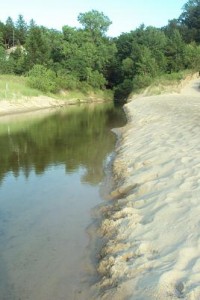Our family has been coming to the same stretch of Michigan sand every summer for 68 years. Although the dimensions of the beach change each year based on the depth of the lake, one beach feature has always been there: the creek.
 As kids we played endlessly in Deer Creek, a shallow, moving mini-river of water flowing mysteriously out of dark woods into Lake Michigan. Despite summers when algae grew on its surface or bark turned the water brown, nothing could keep us out of it.
As kids we played endlessly in Deer Creek, a shallow, moving mini-river of water flowing mysteriously out of dark woods into Lake Michigan. Despite summers when algae grew on its surface or bark turned the water brown, nothing could keep us out of it.
If we left the beach and followed the creek into its deep woods we would find treasure beneath the water: minnows, sparkle-rocks and best of all, gray clay. During the carefree days before we hit the double-digit years, we were sure this clay was the key to flawless beauty. Working carefully on ourselves and each other to cover every square inch of exposed skin, we’d emerge from the woods looking like a potter’s wheel had gone berserk.
In the 1950’s, creek mosquitoes were so thick we often resembled measle-infected kids. Regardless, we followed the creek as far as we could, thinking it “went forever.” Sometimes wild winds knocked trees down, creating perfect bridges. We’d run back and forth, competing to see who could cross the fastest before mis-stepping and crashing into the water. During moments of rest, we’d straddle the “bridge” and talk for hours, sharing childhood secrets. Our parents let us roam, never nervous over our safety. Such freedom is a perk today’s children don’t often enjoy.
 Last summer Jack and I had a carefree adventure of our own. Since the creek flows through the woods behind our cottage, we decided to walk home from the beach in its water. Between fallen trees, slippery rocks, tangled roots, and low-hanging branches, we barely made it. But I felt like a kid again, and it was worth the effort.
Last summer Jack and I had a carefree adventure of our own. Since the creek flows through the woods behind our cottage, we decided to walk home from the beach in its water. Between fallen trees, slippery rocks, tangled roots, and low-hanging branches, we barely made it. But I felt like a kid again, and it was worth the effort.
There aren’t many people following the creek these days. Parents need to keep a closer watch over their children, worrying about who else might be in the woods. (Thankfully there’s never been an incident nearby.) Maybe the kids are all on the internet or playing video games. Whatever the reason, they’re missing one of summer’s delights, not to mention a choice chance to learn about the Creator.
Exploring the features of Deer Creek is like nature’s summer school. Even studying the tiny body of a mosquito can teach children about God’s attention to detail and can initiate a special admiration for him. Although God can be appreciated for his part in the world of technology too, catching minnows in a beach towel or harvesting a bucket of sticky clay might be a superior route to getting acquainted with him.
“God saw all that he had made, and it was very good.” (Genesis 1:31)

I remember the fun we had as youngsters, spending the summer with our cousins at a small cottage in WI, tromping through the forest like wild Indians, with only one adult to supervise us, who gave us plenty of freedom. It was wonderful and exciting, and I thank God for those days.
There was a creek like this near my uncle’s farm in upstate NY – filled with moss-covered shelf rock, as it was in the roots of the Adirondack mountains. I slipped off of one of those rocks one day, almost drowned (I was by myself!), but got out, and got to ride around on the tractor with my uncle for an hour or so until I dried off – we didn’t want Aunt Millie to know about the mishap. Of course, all the green algae in my clothes was a dead giveaway – but the memory is still fond and fresh! You’re right – children these days don’t often get the chance to bank those memories for when they’ll be our age!
Brings back a LOT of memories for me, too. I had a creek like that near where I grew up in NW St. Petersburg, Fla., and my kids had creeks, lakes, and the Ocala Natiional forest, which they roamed all over – usually without adult supervision (because I didn’t know they went that far, until later)…..and their children couldn’t have that freedom, and in retrospect, yes, God surly had His hand upon all of us in our time; the silent prayers of parents were and are still heard. Thanks, Margaret, for the memory.